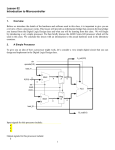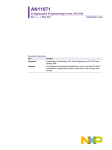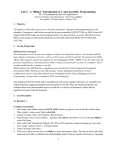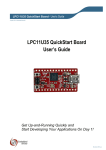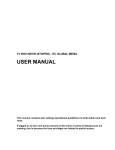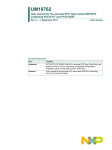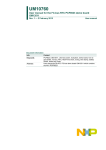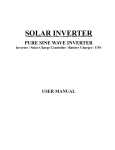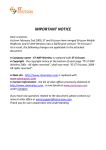Download AN10943 Decoding DTMF tones using M3 DSP library FFT function
Transcript
AN10943 Decoding DTMF tones using M3 DSP library FFT function Rev. 1 — 17 June 2010 Application note Document information Info Content Keywords M3, LPC1300, LPC1700, DSP, DFT, FFT, DTMF Abstract This application note and associated source code example demonstrates how to use the FFT function contained within NXP’s M3 DSP library to decode DTMF tones. AN10943 NXP Semiconductors Decoding DTMF tones using M3 DSP library FFT function Revision history Rev Date Description 1 Initial version 20100617 Contact information For additional information, please visit: http://www.nxp.com For sales office addresses, please send an email to: [email protected] AN10943 Application note All information provided in this document is subject to legal disclaimers. Rev. 1 — 17 June 2010 © NXP B.V. 2010. All rights reserved. 2 of 12 AN10943 NXP Semiconductors Decoding DTMF tones using M3 DSP library FFT function 1. Introduction The M3 DSP library contains a set of commonly used signal processing functions that have been designed and optimized for use with the NXP Cortex-M3 LPC1700 and LPC1300 family of products. This application note describes, with the aid of a software example, how to use the FFT (Fast Fourier Transform) function contained within the library to decode DTMF (Dual Tone Multi Frequency) tones. Note that the DSP library supplied with application note AN10913[2] must be installed in order to build the software example. The application note AN10913 and DSP library can be downloaded at: http://ics.nxp.com/support/documents/microcontrollers/zip/an10913.zip 2. Overview This application note demonstrates how the FFT function contained within the NXP M3 DSP Library can be used to decode DTMF tones. The example software requires the use of a CodeRed RDB1768 development board and a piece of equipment capable of generating DTMF tones (a PC running tone generating software is one option). Tones generated are fed into the RDB1768 board via the Line Input connector. They are digitized by the codec and transferred to the LPC1768 via the I2S interface. The Microcontroller uses the FFT function from the DSP library to compute the different frequencies present in the received data and hence determine the corresponding key. RDB1768 Development Board Tone Generating Equipment 1 2 LCD C o d e c 3 4 5 6 7 8 9 * 0 # NXP M3 FFT Demo LPC1768 180034567*# Buzzer DTMF Tone Fig 1. System block diagram The output of the FFT algorithm, and the key corresponding to the tone received, are displayed on the LCD. Tone received via the codec is output to the buzzer. AN10943 Application note All information provided in this document is subject to legal disclaimers. Rev. 1 — 17 June 2010 © NXP B.V. 2010. All rights reserved. 3 of 12 AN10943 NXP Semiconductors Decoding DTMF tones using M3 DSP library FFT function 3. Background 3.1 FFT basics The Discrete Fourier Transform (DFT) is a commonly used transform in communications, audio signal processing, speech signal processing, instrumentation signal processing, and image processing. It is a technique used for converting a number of complex values from the time domain to the frequency domain. The Fast Fourier Transform (FFT) is an algorithm that is designed to compute the DFT very efficiently. Basically, the FFT is an algorithm that efficiently computes the frequency content of a discrete set of values, i.e., it transforms a time domain signal into the frequency domain. The result of performing an FFT is a set of points often referred to as ‘bins’. Each point, or bin, is a complex value that represents a particular part of the frequency spectrum. The number of points computed (N), and the rate at which the input values were sampled (fs), determines the range of frequencies represented by each bin (fbin). The exact relationship is expressed below: f bin = fs N (1) For example: if a signal is sampled at 16 kHz and a 16-point FFT is performed, the result will consist of 16 data points (bins) each representing a frequency spectrum that is 1 kHz wide. It is important to note that if the input values are real (i.e., the imaginary part is zero), then only the first N/2+1 bins in the FFT result are independent; the remaining bins contain no additional information about the input sequence. Because of this, the maximum frequency present in the results will be half the sampling frequency. The result of an FFT is often represented as a histogram. See Fig 2 for a histogram that represents the example described earlier in this paragraph (assumes input sequence is real). Magnitude 0 Fig 2. AN10943 Application note 1kHz 2kHz 3kHz 4kHz 5kHz 6kHz 7kHz 8kHz Example FFT result All information provided in this document is subject to legal disclaimers. Rev. 1 — 17 June 2010 © NXP B.V. 2010. All rights reserved. 4 of 12 AN10943 NXP Semiconductors Decoding DTMF tones using M3 DSP library FFT function Note that the first FFT output value (bin 0) represents the DC component of the input sequence. The input and output values for the FFT function are complex numbers that have the following form: a + bi (2) For most applications, the input will be a sequence of real values. Therefore, the imaginary part of the number, b, will be zero. The magnitude (M) and phase relationship (θ) between the time domain input sequence, and the corresponding bin frequency, can be calculated from the complex output value as follows: M = a2 + b2 (3) ( ) (4) θ = tan −1 b a 3.2 FFT function implementation The FFT functions contained within the DSP Library operate on 16-bit input values and produce 16-bit output values. The input and output values are arrays of complex numbers. The even entries contain the real part of the corresponding complex number and the odd entries the imaginary part. See Fig 3 for an example. input_buffer[0] = sample_0_real_part; input_buffer[1] = sample_0_img_part; . . input_buffer[8] = sample_4_real_part; input_buffer[9] = sample_4_img_part; Fig 3. FFT input buffer format All FFT functions contained within the DSP Library are Radix-4 implementations. This means that the number of points computed is a multiple of 4, resulting in 64, 256 and 1024 point FFT functions. Radix-2 implementations, where the number of points is a multiple of 2, are also common. However, due to the bank of 16 registers present in the Cortex-M3 core, a Radix-4 implementation offers better performance requiring fewer CPU cycles to compute the same result. The FFT functions do not perform calculations “in place”, which means that the input and output buffers have to be located at different places in memory, i.e., the same buffer cannot be used to hold both input and output values. The number of input samples processed is equal to the number of output points generated. For example, if the 256-point FFT function (vF_dspl_fftR4b16N256) is used, then 256 input samples are required. These input samples actually consist of 512 different 16-bit data values – 256 real and 256 imaginary. The function then generates 512 16-bit output samples – 256 real and 256 imaginary. AN10943 Application note All information provided in this document is subject to legal disclaimers. Rev. 1 — 17 June 2010 © NXP B.V. 2010. All rights reserved. 5 of 12 AN10943 NXP Semiconductors Decoding DTMF tones using M3 DSP library FFT function 3.3 DTMF basics Dual Tone Multi Frequency (DTMF) is a signaling method used by telephones. When a button is pressed on a telephone keypad, a signal (consisting of two sine waves at different frequencies) is transmitted to the receiving equipment. Each key uses a unique combination of two from eight different frequencies (see Fig 4). For example, pressing the ‘5’ key causes a tone consisting of 770 Hz and 1336 Hz sine waves to be transmitted. Fig 4. Tone Frequency 1209 Hz 1336 Hz 1477 Hz 697 Hz 1 2 3 770 Hz 4 5 6 852 Hz 7 8 9 941 Hz * 0 # Keypad frequencies The duration of the tones generated is usually at least 70 ms, however, in some countries the duration could be as low as 45 ms. AN10943 Application note All information provided in this document is subject to legal disclaimers. Rev. 1 — 17 June 2010 © NXP B.V. 2010. All rights reserved. 6 of 12 AN10943 NXP Semiconductors Decoding DTMF tones using M3 DSP library FFT function 4. Example software The example software provided with this application note uses the FFT function to decode DTMF tones. It takes digitized audio data (input via the line-in connector) from the codec and performs an FFT on this data. The FFT result is then examined to see if a tone is present; if so, the results are decoded to determine which key corresponds to this tone. The software operation is summarized in Fig 5. Clear Buffer No Buffer Full? Yes FFT Tone Present? No Yes Decode Display Fig 5. AN10943 Application note Example software flow chart All information provided in this document is subject to legal disclaimers. Rev. 1 — 17 June 2010 © NXP B.V. 2010. All rights reserved. 7 of 12 AN10943 NXP Semiconductors Decoding DTMF tones using M3 DSP library FFT function 4.1 Sampling audio data As can be seen from equation (2), the rate at which the audio data is sampled, and the number of points produced by the FFT algorithm, determines the frequency resolution of the FFT output. The minimum frequency difference between DTFM tones (73 Hz) defines the maximum FFT output resolution that can be used in order to differentiate between tones. To prevent aliasing, the sampling rate must be at least twice the maximum tone frequency, i.e., it should be at least 2954 Hz. If audio data is sampled at 8000 Hz, and a 256-point FFT is performed, the resolution of the output is 31.25 Hz. This is well below the maximum allowable to reliably differentiate between tones. The time taken to obtain 256 samples when sampling at 8000 Hz is 32 ms, which is well below the minimum tone duration of 70 ms. The example code uses the codec fitted to all RDB1768 boards to sample audio data input to the line-in connector. Once a sample has been transferred to the LPC1768, via the I2S interface, an interrupt is generated. The service routine for this interrupt stores the sample as the real part of an FFT input value and sets the imaginary part to zero. It also transmits the received data back to the codec for output via the buzzer. 4.2 FFT Once the main loop detects that the input buffer is full, a 256 point FFT is performed on the received data. The magnitudes of the complex results generated by the FFT are then calculated using equation (3). However, for efficiency the software only calculates the magnitude squared, i.e., the square root operation is not performed. The magnitude squared value roughly corresponds to the power present at a particular frequency and is therefore an adequate value for the purpose of tone detection and decoding. When sampling at 8000 Hz and performing a 256-point FFT, frequencies present in DTMF tones will appear in 7 different output bins (see Table 1). Table 1. DTMF tone - FFT bin table Frequency Bin number 697 Hz 22 770 Hz 25 852 Hz 27 941 Hz 30 1209 Hz 39 1336 Hz 43 1477 Hz 47 1633 Hz 52 4.3 Tone detection In order to detect if a tone is present the power in the bins corresponding to the DTMF frequencies is compared to the total power present across all bins. If the power in the DTMF bins is found to be 25 % higher than the total power a tone is assumed to be present. AN10943 Application note All information provided in this document is subject to legal disclaimers. Rev. 1 — 17 June 2010 © NXP B.V. 2010. All rights reserved. 8 of 12 AN10943 NXP Semiconductors Decoding DTMF tones using M3 DSP library FFT function 4.4 Decoding audio data In order to determine which tone is present only the relative magnitude of the bins listed in Table 1 need to be compared. If a tone is present then two of the bins should contain values that are higher than the others. One group of these bins represents the row and another group the column, see Table 2. Table 2. Key FFT bin - Key table Row bin Column bin 1 22 39 2 22 43 3 22 47 4 25 39 5 25 43 6 25 47 7 27 39 8 27 43 9 27 47 * 30 39 0 30 43 # 30 47 Decoding which key has been pressed is simply a matter of determining which bins in the row (22, 25, 27, 30) and column (39, 43, 47) groups contain the largest value. These values can then be used to obtain the key from a look up table. 4.5 Displaying results After a DTMF tone has been detected and decoded, the corresponding key and the results of the FFT are displayed on the LCD. The magnitude of each bin is displayed and is scaled to fit the available area. 4.6 Hardware setup The example software is designed to run on a CodeRed RDB1768 Evaluation board, the following versions of this board are supported: • RDB1768 Revision 1 • RDB1768 Revision 2 Tones should be input via the 3.5mm Line-In jack (J16). All received audio data is output on the buzzer (ensure that S2 is configured as follows – 1 off, 2 on). AN10943 Application note All information provided in this document is subject to legal disclaimers. Rev. 1 — 17 June 2010 © NXP B.V. 2010. All rights reserved. 9 of 12 AN10943 NXP Semiconductors Decoding DTMF tones using M3 DSP library FFT function 5. References AN10943 Application note [1] Understanding Digital Signal Processing by Richard G. Lyons [2] DSP library for LPC1700 and LPC1300 (AN10913) [3] LPC17xx User Manual (UM10360) [4] Dual-tone multi-frequency signaling, Wikipedia (http://www.nxp.com/redirect/en.wikipedia.org/wiki/Dual-tone_multifrequency_signaling) All information provided in this document is subject to legal disclaimers. Rev. 1 — 17 June 2010 © NXP B.V. 2010. All rights reserved. 10 of 12 AN10943 NXP Semiconductors Decoding DTMF tones using M3 DSP library FFT function 6. Legal information NXP Semiconductors products in such equipment or applications and therefore such inclusion and/or use is at the customer’s own risk. 6.1 Definitions Draft — The document is a draft version only. The content is still under internal review and subject to formal approval, which may result in modifications or additions. NXP Semiconductors does not give any representations or warranties as to the accuracy or completeness of information included herein and shall have no liability for the consequences of use of such information. 6.2 Disclaimers Limited warranty and liability — Information in this document is believed to be accurate and reliable. However, NXP Semiconductors does not give any representations or warranties, expressed or implied, as to the accuracy or completeness of such information and shall have no liability for the consequences of use of such information. In no event shall NXP Semiconductors be liable for any indirect, incidental, punitive, special or consequential damages (including - without limitation lost profits, lost savings, business interruption, costs related to the removal or replacement of any products or rework charges) whether or not such damages are based on tort (including negligence), warranty, breach of contract or any other legal theory. Notwithstanding any damages that customer might incur for any reason whatsoever, NXP Semiconductors’ aggregate and cumulative liability towards customer for the products described herein shall be limited in accordance with the Terms and conditions of commercial sale of NXP Semiconductors. Right to make changes — NXP Semiconductors reserves the right to make changes to information published in this document, including without limitation specifications and product descriptions, at any time and without notice. This document supersedes and replaces all information supplied prior to the publication hereof. Applications — Applications that are described herein for any of these products are for illustrative purposes only. NXP Semiconductors makes no representation or warranty that such applications will be suitable for the specified use without further testing or modification. Customers are responsible for the design and operation of their applications and products using NXP Semiconductors products, and NXP Semiconductors accepts no liability for any assistance with applications or customer product design. It is customer’s sole responsibility to determine whether the NXP Semiconductors product is suitable and fit for the customer’s applications and products planned, as well as for the planned application and use of customer’s third party customer(s). Customers should provide appropriate design and operating safeguards to minimize the risks associated with their applications and products. NXP Semiconductors does not accept any liability related to any default, damage, costs or problem which is based on any weakness or default in the customer’s applications or products, or the application or use by customer’s third party customer(s). Customer is responsible for doing all necessary testing for the customer’s applications and products using NXP Semiconductors products in order to avoid a default of the applications and the products or of the application or use by customer’s third party customer(s). NXP does not accept any liability in this respect. Export control — This document as well as the item(s) described herein may be subject to export control regulations. Export might require a prior authorization from national authorities. 6.3 Trademarks Notice: All referenced brands, product names, service names and trademarks are property of their respective owners. Suitability for use — NXP Semiconductors products are not designed, authorized or warranted to be suitable for use in life support, life-critical or safety-critical systems or equipment, nor in applications where failure or malfunction of an NXP Semiconductors product can reasonably be expected to result in personal injury, death or severe property or environmental damage. NXP Semiconductors accepts no liability for inclusion and/or use of AN10943 Application note All information provided in this document is subject to legal disclaimers. Rev. 1 — 17 June 2010 © NXP B.V. 2010. All rights reserved. 11 of 12 AN10943 NXP Semiconductors Decoding DTMF tones using M3 DSP library FFT function 7. Contents 1. 2. 3. 3.1 3.2 3.3 4. 4.1 4.2 4.3 4.4 4.5 4.6 5. 6. 6.1 6.2 6.3 7. Introduction .........................................................3 Overview ..............................................................3 Background .........................................................4 FFT basics .........................................................4 FFT function implementation..............................5 DTMF basics ......................................................6 Example software................................................7 Sampling audio data ..........................................8 FFT ....................................................................8 Tone detection ...................................................8 Decoding audio data ..........................................9 Displaying results ...............................................9 Hardware setup..................................................9 References .........................................................10 Legal information ..............................................11 Definitions ........................................................11 Disclaimers.......................................................11 Trademarks ......................................................11 Contents.............................................................12 Please be aware that important notices concerning this document and the product(s) described herein, have been included in the section 'Legal information'. © NXP B.V. 2010. All rights reserved. For more information, please visit: http://www.nxp.com For sales office addresses, please send an please send an email to: [email protected] Date of release: 17 June 2010 Document identifier: AN10943
















